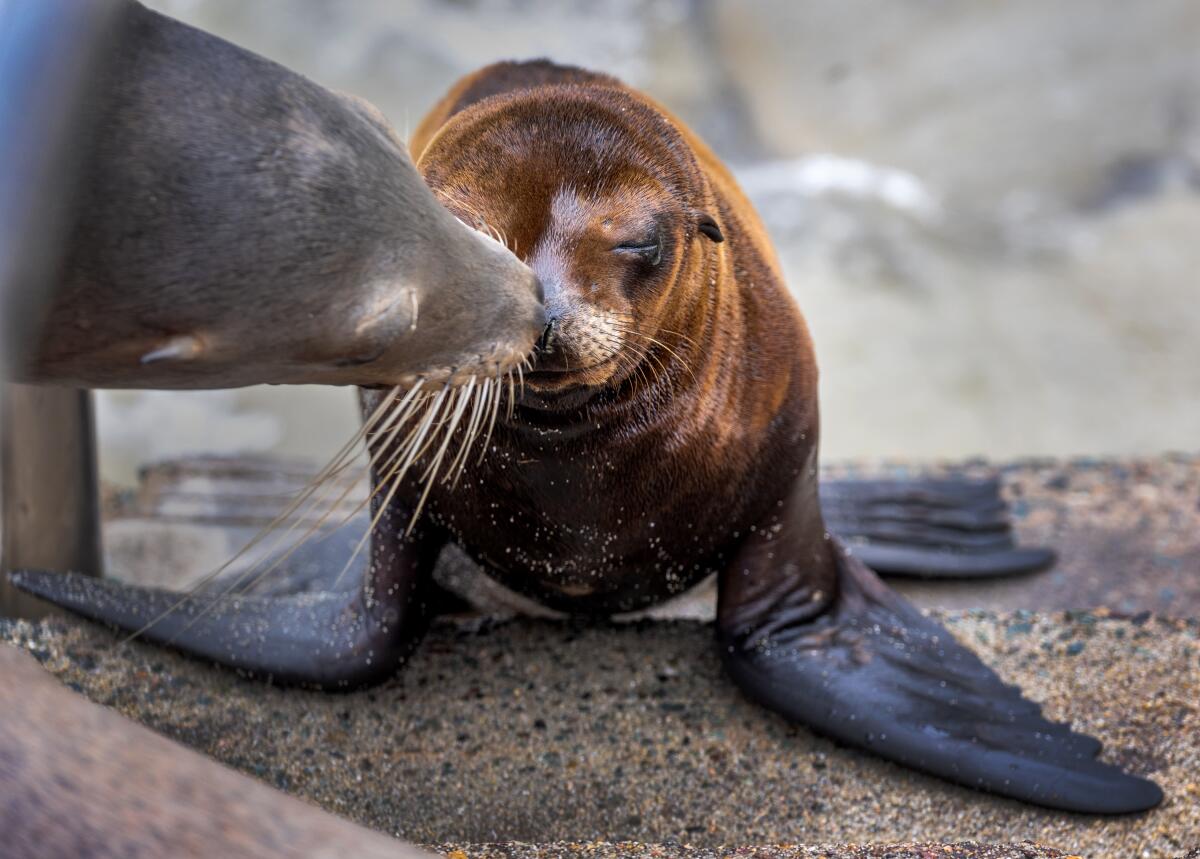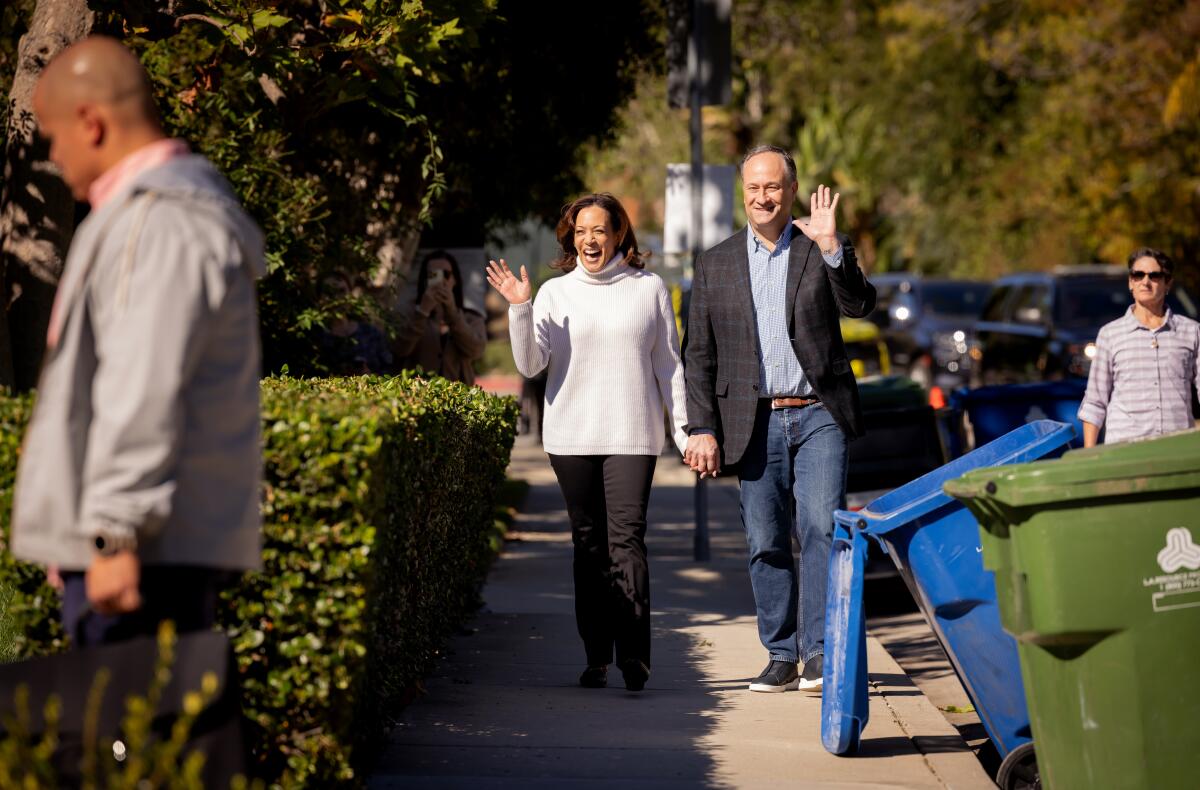Sea lions — and their stench — rule La Jolla’s coastline

- Share via
Good morning, and welcome to the Essential California newsletter. Here’s what you need to know to start your weekend:
- Sea lions conquered a beach town’s coastline, and others could be next.
- Living next to Kamala Harris has its up and downs, her Brentwood neighbors say.
- This world-record corn maze is an experiment in human psychology.
- And here’s today’s eNewspaper
You're reading the Essential California newsletter
Our reporters guide you through the most important news, features and recommendations of the day.
You may occasionally receive promotional content from the Los Angeles Times.
Sea lions — and their stench — rule La Jolla’s coastline
A battle is underway in La Jolla, after sea lions conquered the town’s beaches, claiming them as their own breeding grounds.
The phenomenon has attracted busloads of tourists who take pictures of cuddly-looking sea lions and post them on social media, captivating a large online audience that has rushed to the defense of the mammals.
But nearby residents are over it. The sea lions are constantly pooping, and the smell can drift blocks away. A group called Citizens for Odor Nuisance Abatement unsuccessfully tried suing local officials into doing something about the smell in 2013, arguing local businesses were suffering.
What’s happening at La Jolla is significant for several reasons, as my colleague Jack Flemming explains in this fascinating deep dive that, yes, includes plenty of photos of the sea lions. Here are some key takeaways from Jack’s reporting.
Sex, food, and climate change are driving the sea lions’ coastline conquest
The sea lion population has exploded, rising from about 90,000 in the 1970s to around 250,000 today. That rebound is largely thanks to a federal law passed in 1972 that made it illegal to hunt and kill sea lions and other marine animals.
With their increasing numbers, sea lions are running out of space at their longtime home in the uninhabited Channel Islands, where most sea lions breed. So the mammals have branched out to colonies on the coastline, moving into areas close to food and away from humans.
And that’s what makes the situation at La Jolla strange — there are people seemingly everywhere, taking selfies with the sea lions and documenting their every move, including farts. Many sea lion pups have died because of human interference, such as separating pups when their mothers are getting food by crowding around them, forming unintentional blockades, Jack reports.
So why La Jolla? The move might be due to El Niño events and heat waves that have warmed waters and killed off fish that sea lions prey upon, Sharon Melin, the lead sea lion biologist at the National Oceanic and Atmospheric Administration, told Jack.
“As habitats change and the climate changes, sea lions will be moving,” Melin said. “They’ll be looking for places to rear their young, and they’ll show up in places we’ve never thought about.”

Sea lions may be swimming to other beach towns, and communities need to be prepared
“Experts say La Jolla is just the first beachhead in a larger campaign to claim, or maybe reclaim, territory,” Jack reports. “As overcrowding and water temperatures disrupt the sea lion population, they say new colonies will form up and down the coast — whether locals want them there or not.”
Communities have some playbooks for dealing with sea lions. One can be found in San Francisco, where boats were removed from Pier 39 to accommodate sea lions after a group popped up in 1989.
If locals don’t want sea lions on their coastline, they should act quickly. Legal methods for deterring the mammals include fences, rails, lights and noisemakers.
But for La Jolla, it may be too late. Once a breeding ground is established, it’s hard to stop, Jack reports.
The week’s biggest stories

A look at Kamala Harris’ roots in California
- Living on the same block as Harris is a delight and an annoyance, her Brentwood neighbors say.
- California residents share how they’ve been affected by decisions made by Harris when she served as the top prosecutor for the state and San Francisco.
- Here’s a look at Harris’ and Trump’s campaign promises and how likely they are to fulfill them if elected.
- Harris has been called both “soft” and “tough” on crime. But what does her record show?
A new clergy abuse settlement pushes the total payouts from the L.A. Catholic Church to more than $1.5 billion
- The Archdiocese of Los Angeles has agreed to pay $880 million to victims of clergy sexual abuse dating back decades in the largest settlement involving the Catholic Church.
- More than 300 priests who worked in the archdiocese in Los Angeles have been accused in public records of sexually abusing minors.
Gas prices will likely go up with the closure of the Phillips 66 refinery complex, analysts say
- This week’s decision by Phillips 66 to shutter its refinery in Wilmington next year complicates California’s attempt to manage a smooth transition away from gasoline.
- Environmental and community activists welcomed the news of the refinery’s closure as complaints of acrid odors, fiery accidents, soot and harmful emissions have gained new resonance in recent years.
Baby food pouches have never been more popular with kids. That might not be a good thing
- The pouches, which have become a convenient option for busy parents, can have several consequences for children if overused, doctors and other experts warn.
- The popularity of pouches has also exposed shortcomings in the federal regulation of baby and toddler foods. The FDA earlier this year recalled 3 million pouches that contained extremely high levels of lead.
More big stories
- Dodgers can’t overcome Jack Flaherty’s struggles in NLCS Game 5 loss to Mets.
- Sean “Diddy” Combs choked an intern and put a UCLA staffer in headlock during a brawl, a document we obtained from the L.A. County prosecutors alleges.
- Los Angeles’ $22-billion homelessness problem gives leaders a choice: double down or change strategies.
- A program for struggling Black students at LAUSD has been upended after a civil rights complaint from a conservative Virginia group.
- Tech titans have poured millions of dollars into San Francisco mayor’s race, hoping to set city on a new course.
- A candidate running in South Los Angeles was charged with stabbing a woman in 1993. She says they’re friends.
Get unlimited access to the Los Angeles Times. Subscribe here.
This week’s must reads
A “Locally hated/Dyslexic Hairstylist” battles the Christian right in a Texas town. Adrienne Quinn Martin is the only elected Democrat in deep-red Hood County, Texas. Once underestimated by her enemies, Martin has found ways to get under their skin. “I get furious about an injustice that happens to someone else,” she said. “It’s a kind of a curse, to be honest.”
More great reads
- Korean Americans, disillusioned with the U.S., are returning to their homeland in record numbers.
- This 71-year-old pole dancer defies expectations — and gravity — in age-obsessed L.A.
- L.A.’s. new graffiti wars feature a bold generation of taggers hitting high-profile targets.
- Gen Z wants to quit vaping. Can a new wave of trendy products help?
- A mountain lion stalked a couple’s campsite. The boyfriend went back to sleep.
How can we make this newsletter more useful? Send comments to [email protected].
For your weekend
Going out
- 🌽 Navigating the world-record corn maze at Cool Patch Pumpkins is a test of the human psyche.
- 🌮 Looking for creative and unique tacos? Here are 14 places to check out in Los Angeles.
- 🎞️ Andrew Garfield, who stars in “We Live in Times,” says he questions everything. “I don’t know where my calling is.”
- 👗 It’s far from a wrap for Diane von Furstenberg, whose life and work are the focus of an exhibition at the Skirball Cultural Center.
- 🍿 The freewheeling “Anora” is a stripper’s fairy tale crashing to Earth, our critic writes.
Staying in
- 📺 Franchises took over reality TV. Now they threaten its success.
- 🔍 If L.A.’s a mystery, the Harry Bosch books are a brilliant, gripping way to solve it, our critic writes.
- 🍴 Looking for something to cook up for Día de Muertos? This fall dish unwraps like a gift.
- 🧑🍳 Here’s a recipe for homemade PayDay bars.
- ✏️ Get our free daily crossword puzzle, sudoku, word search and arcade games.
How well did you follow the news this week? Take our quiz.
Which electric car company unveiled its prototype for a driverless taxi dubbed the Cybercab last week? Plus nine other questions from our weekly news quiz.
Have a great weekend, from the Essential California team
Hunter Clauss, multiplatform editor
Check our top stories, topics and the latest articles on latimes.com.
Sign up for Essential California
The most important California stories and recommendations in your inbox every morning.
You may occasionally receive promotional content from the Los Angeles Times.







